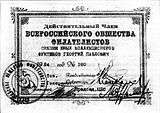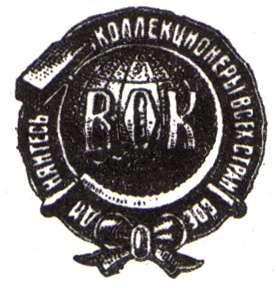All-Russian Society of Philatelists
All-Russian Society of Philatelists (Russian: Всероссийское общество филателистов) was the first national philatelic organisation in Soviet Russia established in 1923. Later on, it was subsequently renamed and reorganised into the All-Union Society of Philatelists (Russian: Всесоюзное общество филателистов)[lower-alpha 2] and the All-Union Society of Collectors (Russian: Всесоюзное общество коллекционеров).[1][2]

Всероссийское общество филателистов | |
 Emblem of the organisation when it became the All-Union Society of Collectors | |
| Abbreviation | Russian: ВОФ (VOF), Russian: ВОК (VOK) |
|---|---|
| Predecessor | Moscow Society of Philatelists and Collectors |
| Successor | All-Union Society of Philatelists, All-Union Society of Collectors |
| Formation | 6 April 1923 |
| Founded at | Moscow, USSR |
| Extinction | late 1930s |
| Type | NGO |
| Legal status | national association |
| Purpose | philately, scripophily,[lower-alpha 1] numismatics, ex-libris collection |
| Headquarters | 31 Herzen Street |
| Location |
|
| Coordinates | 55°45′27″N 37°35′54″E |
Region | USSR |
Membership (1926) | ~3,000 members |
Official language | Russian |
Secretary General | Leongard Eichfuss |
Chairman of the Board | Vladimir Repman (1923–1924) Leongard Eichfuss (1924–1925) Boris Bildin (1925–1928) Kazimir Dunin-Barkovsky (1928–1934) |
Deputy Chairman of the Board | B. F. Pamfilov |
Second Secretary | B. S. Pashkov |
Treasurer | E. I. Markevich |
Main organ | Board of the Society Publication: Soviet Philatelist |
| Remarks | private persons, 51 regional branches (1927) |
History
In Soviet Russia, the first philatelic organisation, Moscow Society of Philatelists and Collectors, appeared in 1918 in Moscow.[2] In 1922, the idea of a new countrywide philatelic society was supported by the Russian Bureau of Philately at the RSFSR National Commissariat of Post and Telegraphs. On 15 March 1923, the charter of the All-Russian Society of Philatelists was approved. On 6 April 1923, its first meeting took place in Moscow.[1][3]
In 1923, 643 collectors joined the All-Russian Society of Philatelists.[4] The society's branches worked in Yerevan, Tiflis, Tashkent, Ashgabat, Baku, and other cities. In 1924–1925, the First All-Union Philatelic Exhibition was held. The All-Russian Society of Philatelists published the Soviet Philatelist magazine (1922–1932). It existed till the late 1930s.[1][3]
See also
Notes
- Collecting stock and bond certificates.
- This organisation was re-established in 1966 as the All-Union Society of Philatelists.
References
- Polchaninov, R. (1986). Translated by G. Shalimoff; D. Skipton. "From the history of philately in the USSR". Rossica: Journal of the Rossica Society of Russian Philately. 108–109: 46–52. ISSN 0035-8363. Archived from the original on 2015-05-15. Retrieved 2015-05-15.
Reprinted from 'Novoye Russkoye Slovo', New York, 27 July 1986, in the column 'Collector's Corner'.
- Владинец, Н. И. (1977). "Филателия" [Philately]. In Прохоров, А. М. (ed.). Большая советская энциклопедия: в 30 т. (1970–1979) [The Great Soviet Encyclopedia] (in Russian and English). 27 (Ульяновск – Франкфорт) (3rd ed.). М. [Moscow]: Советская энциклопедия [Soviet Encyclopedia]. Retrieved 2015-06-08.
- Ivanova, V. (2015-02-23). "Philately in Russia, Part 2". Russia-IC: Culture & Arts: Manners, Customs and Traditions. Russia-InfoCentre; Guarant-InfoCentre. Archived from the original on 2015-06-21. Retrieved 2015-06-21.
- Grant, J. (July 1995). "The socialist construction of philately in the early Soviet era". Comparative Studies in Society and History. 37 (3): 476–493. doi:10.1017/S0010417500019770. ISSN 0010-4175. JSTOR 179216.
External links

- Budnik, D. (May 2004). "Brief marks of development of philately". Forum filatelia e francobolli: Immagini relative ai miei messaggi per il Forum filatelia e francobolli, pagina 67. CIFR — Centro Italiano Filatelia Resistenza. Archived from the original on 2015-05-25. Retrieved 2015-05-26.